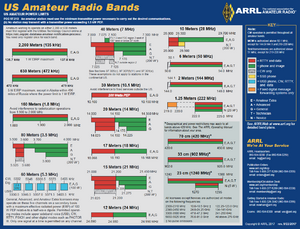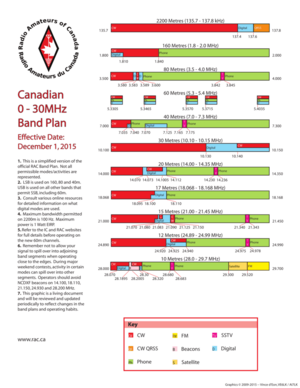Band Plans: Difference between revisions
(import) |
(→Canada: Better description of Canadian amateur operator privileges.) Tag: Reverted |
||
| Line 9: | Line 9: | ||
[http://www.arrl.org/files/file/Regulatory/Band%20Chart/Band%20Chart%20-%2011X17%20Color.pdf Original document] | [http://www.arrl.org/files/file/Regulatory/Band%20Chart/Band%20Chart%20-%2011X17%20Color.pdf Original document] | ||
==Canada== | ==Canada== | ||
Holders of a Canadian Amateur Radio Operator Certificate with the Basic qualification have all band and mode privileges at at 50 MHz and higher. Certificate holders who scored higher than 80% on the Basic exam also gain all band and mode privileges on and below the 10-m band. Certificate holders can also gain access to those HF bands by obtaining a Morse Code qualification (5 wpm) or by taking and passing the Advanced amateur exam. The Advanced qualification allows higher transmitter power and other non-operating privileges (e.g., trustee of repeater stations and club stations. All exams are conducted by an Accredited Examiner. | |||
===Canada HF=== | ===Canada HF=== | ||
[[File:Canadian Band Plan.png|thumb]] | [[File:Canadian Band Plan.png|thumb]] | ||
An image created by the RAC describing the Canadian amateur radio frequency allocations per band | An image created by the RAC describing the Canadian amateur radio frequency allocations per band. | ||
[https://www.rac.ca/rac-0-30-mhz-band-plan/ Original Document] | [https://www.rac.ca/rac-0-30-mhz-band-plan/ Original Document] | ||
===Canada VHF/UHF=== | ===Canada VHF/UHF=== | ||
There is no singular offical chart for bands above 30MHz, instead there are [https://www.rac.ca/operating/bandplans/ charts per band]. | There is no singular offical chart for bands above 30MHz, instead there are [https://www.rac.ca/operating/bandplans/ charts per band]. | ||
==New Zealand== | ==New Zealand== | ||
The NZART provides a [https://www.nzart.org.nz/assets/info/band-plans/2021-bandplan.pdf very detailed plan] that is not possible to embed here. | The NZART provides a [https://www.nzart.org.nz/assets/info/band-plans/2021-bandplan.pdf very detailed plan] that is not possible to embed here. | ||
Revision as of 14:58, 4 June 2023
A collection of some band plans describing the frequency allocations for each ham band.
United States (ARRL)

The US Band plan consists of frequency allocations for amateurs on bands from 2200 meters to 23 centimeters.
Canada
Holders of a Canadian Amateur Radio Operator Certificate with the Basic qualification have all band and mode privileges at at 50 MHz and higher. Certificate holders who scored higher than 80% on the Basic exam also gain all band and mode privileges on and below the 10-m band. Certificate holders can also gain access to those HF bands by obtaining a Morse Code qualification (5 wpm) or by taking and passing the Advanced amateur exam. The Advanced qualification allows higher transmitter power and other non-operating privileges (e.g., trustee of repeater stations and club stations. All exams are conducted by an Accredited Examiner.
Canada HF

An image created by the RAC describing the Canadian amateur radio frequency allocations per band.
Canada VHF/UHF
There is no singular offical chart for bands above 30MHz, instead there are charts per band.
New Zealand
The NZART provides a very detailed plan that is not possible to embed here.